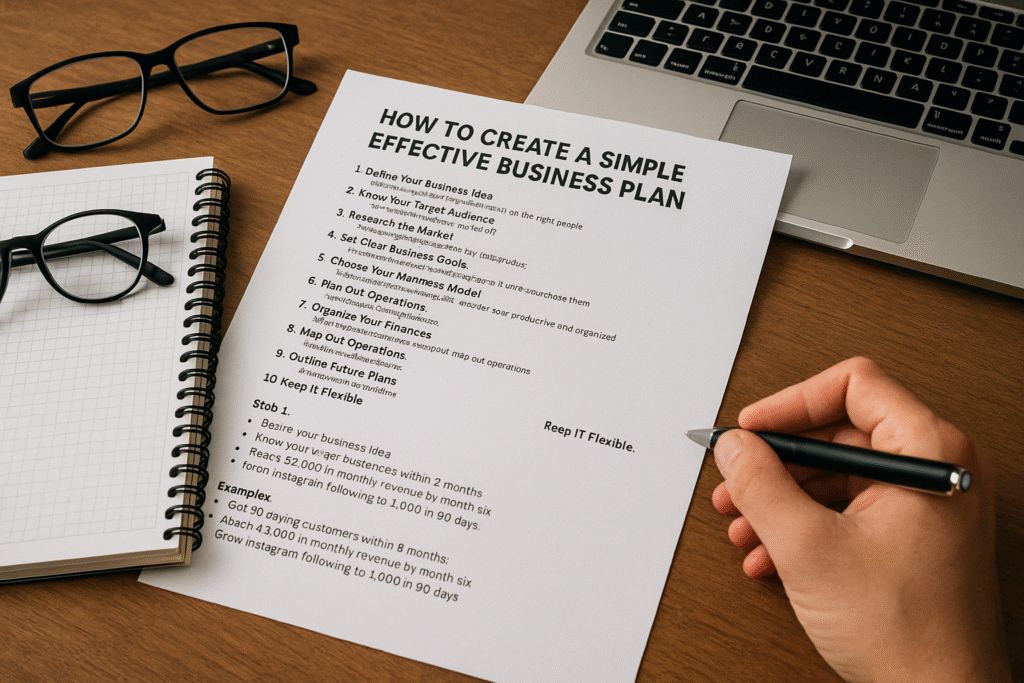Many beginner entrepreneurs skip creating a business plan because they think it’s too complicated or unnecessary. But the truth is, a business plan doesn’t need to be long or complex to be effective. A simple, clear business plan helps you focus your goals, understand your market, and organize your path forward.
In this article, we’ll walk you through how to create a straightforward business plan—even if you’re just starting out and have no experience.
Why You Need a Business Plan
A business plan serves as your roadmap. It:
- Clarifies your vision
- Defines your target audience
- Helps you organize your ideas
- Keeps you on track with goals
- Is essential if you ever need funding or partnerships
Think of it as a guide to keep you grounded when things get chaotic (which they often do in business).
Step 1: Define Your Business Idea
Start by clearly stating what your business does. Answer these questions:
- What product or service do you offer?
- What problem does it solve?
- What makes it different from others?
Example:
“We help busy professionals eat healthier by delivering fresh, ready-to-eat vegan meals tailored to their lifestyle.”
Step 2: Know Your Target Audience
Your business will succeed only if it serves the right people. Describe your ideal customer:
- Age, gender, location
- Occupation and income level
- Interests and values
- Common pain points
Example:
“Our ideal customer is a health-conscious professional between 25 and 40 years old, living in urban areas, with a busy schedule and a mid-to-high income.”
Step 3: Research the Market
Understanding your industry is crucial. In this section, write about:
- Your main competitors
- What they offer
- How your business is different (your unique value proposition)
- Trends in your industry
You don’t need deep statistics—just enough to prove you’ve done your homework.
Step 4: Set Clear Business Goals
Your goals will give you direction. Make them SMART:
- Specific
- Measurable
- Achievable
- Relevant
- Time-bound
Example:
- Get 50 paying customers within 3 months
- Reach $2,000 in monthly revenue by month six
- Grow Instagram following to 1,000 in 90 days
Step 5: Choose Your Business Model
Explain how your business will make money. Will you:
- Sell products online?
- Offer one-on-one services?
- Use subscriptions?
- Earn commissions or referrals?
Also include basic pricing strategies and why you chose them.
Step 6: Plan Your Marketing
This is where you explain how people will hear about your business. Focus on:
- Channels (social media, email, word of mouth, etc.)
- Messaging (what you’ll say to attract interest)
- Tools (Instagram, Google Ads, blog, etc.)
You don’t need a big budget—just consistency and a plan to get in front of your audience.
Step 7: Organize Your Finances
Even if your business is just getting started, plan how money will move:
- Startup costs (website, tools, branding, etc.)
- Monthly expenses (subscriptions, marketing, materials)
- Revenue expectations
- Break-even point (when you expect to cover your costs)
Use a simple spreadsheet to keep track of everything. This helps prevent surprises and keeps you in control.
Step 8: Map Out Operations
Describe how your business will run day to day:
- Who is responsible for what (even if it’s just you)
- What tools or platforms you’ll use
- How you’ll deliver your product or service
- What systems you’ll need (booking, payment, delivery, etc.)
Even basic operations planning can help you stay productive and organized.
Step 9: Outline Future Plans
If you have big dreams, write them down! Investors and partners love seeing growth potential.
Examples:
- Launching new products or services
- Hiring a team
- Expanding to new markets
- Opening a physical location
Even if it’s long-term, it shows that you’re thinking ahead.
Step 10: Keep It Flexible
Your first business plan is not your final one. It’s a living document. Review it every few months to:
- Adjust your goals
- Add new ideas
- Refocus your priorities
- Track your progress
Adapt as you learn, grow, and evolve.
Final Advice: Keep It Simple, Keep It Moving
Don’t let the idea of a business plan overwhelm you. You’re not writing a corporate report—you’re creating a tool to help you grow. A good business plan is simple, honest, and actionable.
Take it one section at a time, and before you know it, you’ll have a complete blueprint that keeps your dream business on track.

